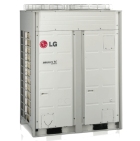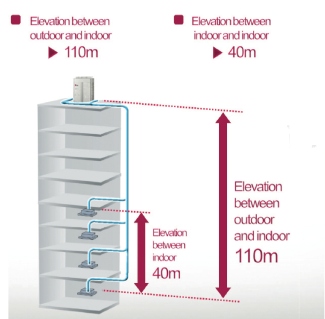LG delivers step change in VRF air conditioning

LG’s latest VRF air-conditioning system, Multi V IV, can achieve a 40% improvement in integrated partial-load efficiency, compared with the previous-generation Multi V III, to achieve an EER of 6.0 compared with 4.3. There is also a 30% improvement in system efficiency to 4.85 compared with 3.73, based on a 20 hp unit in cooling-only mode. Four innovative technologies in the new range are responsible for these substantial improvements.
Over a third of the improvement in integrated part-load efficiency (15 percentage points) is due to all-inverter control. The frequency range is from 15 to 150 Hz, compared with 20 to 100 Hz for Multi V III.
The next biggest improvement comes from being able to vary the path through the heat exchanger, which accounts for 12 percentage points of the 40% overall improvement.
The heat exchanger is divided into two sections, which are used in series at low velocity for heating and in parallel and high velocity for cooling — improving heat-exchange efficiency in both modes of operation.
Parallel operation of the heat exchanger in heating mode also brings benefits when the coil is defrosted. One part of the coil can be defrosted while the other part continues to deliver heating — rather than there being no heat at all.
Compressor operation adds 8 percentage points to efficiency in two ways.
One is a 2-stage compression effect depending on whether the returning refrigerant is at low pressure or mid pressure. Refrigerant returning at mid pressure requires less work from the compressor and improves heating performance and energy efficiency.

The second aspect of compressor operation is how oil is handled. Oil that has been separated from the refrigerant coming off the compressor is returned at high pressure straight back to the compressor. The normal approach is for oil to be returned to the compressor along with the returning refrigerant.
Oil is returned to the compressor only when a level sensor indicates that it is required rather than at fixed intervals of, say 8 h. Units on test have run for 200 days without oil needing to be recovered.
Another trick is to vary the amount of refrigerant that is being circulated according to the load — achieving 3 percentage points improvement in efficiency.
Multi V IV also offers significant design and installation benefits. An outdoor unit on the roof of a building can be as much as 110 m above the lowest indoor unit, compared with a more normal 50 m. In addition, the elevation between indoor units can be up to 40 m, compared with a more normal 15 m.
Another feature to reduce installation time and increase reliability is the elimination of the need for a common pipe for refrigerant between outdoor units. Outdoor units are relatively light, too, with the 300 kg for a 20 hp unit said to be 25% lighter than other comparable units. Some units are 33% lighter. If part of a system fails, refrigerant is automatically collected to minimise loss. If an indoor unit fails, the refrigerant is collected to the outdoor unit. If an outdoor unit fails, refrigerant is pumped to the indoor units and pipework.







